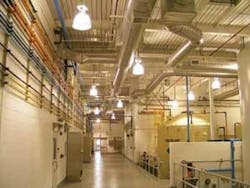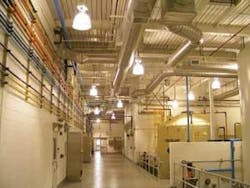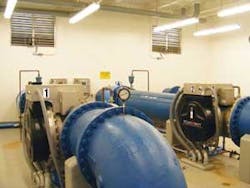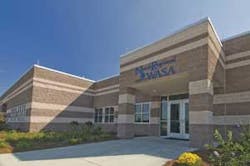Meeting Water Needs in North Carolina
By William B. Dowbiggin, Carl S. Frizzell, and C. Brandon Garner.
In 2000, eight water and sewer service providers in North Carolina–the towns of Ayden, Grifton, Pink Hill; Bell Arthur, Deep Run, Eastern Pines, and North Lenoir water corporations; and the city of Kinston – formed the Neuse Regional Water and Sewer Authority (NRWASA) with the intent of developing regional solutions to current and future water supply needs. Soon after, the state of North Carolina imposed new groundwater withdrawal regulations that mandated phased reductions based on dwindling groundwater supplies. In order to meet these stricter guidelines, NRWASA and CDM partnered to find a solution that would enable them to efficiently and economically continue providing water to the eight member utilities.
After establishing water use requirements, pollutant levels, and raw water quality, the engineering team evaluated the Neuse River basin-wide plan and researched data related to area water treatment systems already using the river water. CDM provided pilot testing of the Neuse River that revealed it was amenable to a variety of treatment processes.
In response, CDM planned, designed, and provided construction oversight for the new 15 mgd water treatment plant as part of a water system project that also included more than 74 miles of water transmission mains that connect the eight systems. Drawing and treating water from the Neuse River, in conjunction with groundwater supplied by NRWASA members, reduces the region’s reliance on groundwater and diminishing aquifer supplies.
This collaborative-approach solution allows the group to continue providing potable water for the approximately 100,000 customers in Lenoir and Pitt counties while gradually reducing the percentage of water drawn from the diminishing aquifers to meet the ultimate goal of 75 percent reduction by 2018.
Multiple Treatments
The water plant design includes multiple treatment barriers, including ultraviolet (UV) light disinfection and activated carbon adsorption. These treatments produce high-quality drinking water that meets current and proposed regulations by addressing the distinctive characteristics of the supply water. UV disinfection–the first application in North Carolina at a large municipal water treatment plant–was included to serve as an extra disinfection barrier for microbial contaminants, such as the Cryptosporidium protozoan, present in river water. The UV system consists of two medium-pressure, 30-inch diameter reactors, each capable of inactivating more than three logs of Cryptosporidium with a minimum transmittance of 82 percent.
Granular activated carbon (GAC) was added to the filters to help remove known and unidentified organic compounds and synthetic organic chemicals, such as endocrine disruptors and pharmaceuticals, also improving the taste and odor of the treated water.
Before selecting these multiple barrier treatments, various options were examined, including up-flow clarifiers, dissolved air flotation, pretreatment with a magnetic ion exchange resin, micro/ultra/nano-filtration, and ultraviolet disinfection. Capital, operations and maintenance, and lifecycle cost analyses were developed and allowed the team to evaluate operations and treatment processes under typical conditions and assess performance and reliability for prospective use under future/projected flow, strength, and loading conditions.
Energy Efficiency
Variations in the Neuse River levels, quality, and other factors not only necessitated the resilient, multi-barrier treatment process, but also lead to pumping challenges. During the design phase, the engineering team explored sustainable ways to reduce operations and maintenance costs while addressing the needs dictated by the river.
For example, the elevated 30-million gallon raw water impoundment offers flexibility, enabling the plant intake to be shut down in the event of a spill or short-term change in river water quality after a heavy rain. Also, the elevated impoundment allows water to flow to the plant with the help of gravity and allows NRWASA the option of pumping from the river only at night, during off-peak electrical periods.
Energy-related electrical costs are further reduced by the substantial amount of treated water storage, which allows NRWASA to avoid high peaks in pumping rates during elevated electrical demand periods, and by the load-shedding electrical program, which places the plant on standby generator electrical power when requested by the electrical provider, the city of Kinston.
Recycling plant backwash water reduces discharges back to the river and also saves on pumping costs. Where pumps are used, variable speed drives allow efficient operation despite variable water levels and accommodate changes in flow rates and demands.
Customized Control
The $58 million water treatment facility benefits from a state-of-the-art supervisory control and data acquisition (SCADA) system, which automates many processes and provides a computerized view into the plant process areas, enabling efficient management and monitoring of the entire water plant from the control room.
The control system was designed to meet stringent security requirements; therefore, the plant computer servers are located in a secure area, completely separate from the operators and the general public. The actual plant processes are controlled by specialized industrial programmable logic controllers (PLCs), which are extremely reliable. Nevertheless, in the rare case that a controller does fail, the PLCs are set up in a redundant arrangement, meaning the backup controller assumes control over plant processes so quickly no interruptions occur.
Benefits of Collaboration
The expanded regionalization of NRWASA over a broader project service area enabled the utilities to reap additional social and economic benefits as the Central Coastal Plain Capacity Use Area Rules are intended to help sustain the valuable groundwater through balanced withdrawals and replenishment.
Regionalization is a sensible option for these rural communities since it facilitates ease of compliance and only requires monitoring one facility instead of eight. It also helps the area’s continued growth by installing new, modern infrastructure that contributes to economic redevelopment.
The Neuse WTP is part of a complete $138.7 million water system – the largest United States Department of Agriculture Rural Development-funded water project in the nation to date – and it is fully funded by grants and loans. NRWASA receives additional revenues through member contributions, which are proportionate to the number of customers served by each member, ensuring costs are fair, based on the benefits received.
Since it went online September 2, 2008, the new water treatment plant has been successfully treating water for the region’s customers. This project recently received a 2009 Engineering Excellence Grand Award in the water and wastewater category from the American Council of Engineering Companies (ACEC) of North Carolina. WW
About the Authors:
William B. Dowbiggin, P.E., BCEE, is a senior engineer with CDM; Carl S. Frizzell, Ph.D., P.E., is a civil engineer with CDM; and C. Brandon Garner is Water Treatment Plant Superintendent for the Neuse Regional Water and Sewer Authority.



